MP Board Class 9th Social Science Solutions Chapter 9 History of Ancient India
MP Board Class 9th Social Science Chapter 9 Text Book Questions
Choose the Correct Answer:
Question 1.
Which of the following cities is not related to Indus civilization?
(a) Mohen-jo-daro
(b) Kalibanga
(c) Lothal
(d) Pataliputra.
Answer:
(d) Pataliputra.
Question 2.
Which of foreign travelers come to India during Chandra Gupta Maurya’s period?
(a) Falien
(b) Arian
(c) Hieun Tsang
(d) Megasthenese.
Answer:
(d) Megasthenese.
Match the following:

Answer:
1. (d) Magadh
2. (a) Kautilya
3. (b) Mahatma Buddha
4. (c) Vikrmaditya
5. (e) Kalinga War
Fill in the blank:
- The founder of the Jain religion was ……………….
- Mahatama Buddha attained enlightenment under the …………… tree.
- India’s two great epics are the …………….. and …………….
- The founder of the Gupta’s dynasty was …………….
Answer:
- Vardhaman Mahavir
- Pipal
- Mahabharta, Ramayan
- Sri Gupta
![]()
MP Board Class 9th Social Science Chapter 9 Very Short Answer Type Questions
Question 1.
Write names of Vedas.
Answer:
There are four Vedas:
- Rigveda
- Samveda
- Yajurveda
- Atharvaveda.
Question 2.
Write the names of the four chief cities of the Indus civilization.
Answer:
The four chief cities of Indus civilization are:
- Mohen-jo-daro
- Harappa
- Ropar
- Kalibanga.
Question 3.
Who was Megasthenese? Name the book written by him.
Answer:
Megasthenese w’as a foreign traveler who came to India during the period of Chandra Gupta Maurya. The name of the book written by him is Indica.
Question 4.
Write the names of chief education institutions of ancient India.
Answer:
- Taxshila University
- Nalanda University
Question 5.
Who was Kautilya? Write the name of the book written by him.
Answer:
Kautilya was a famous economist during the period of Chandra Gupta Maurya. The name of the book written by him is Arthashastra.
Question 6.
Which Gupta ruler was successful in repulsing the Huna attacks?
Answer:
Skanda Gupta was successful in repulsing the Huna attacks.
![]()
MP Board Class 9th Social Science Chapter 9 Short Answer Type Questions
Question 1.
Who discovered the cities of Mohen-jo-daro and Harappa?
Answer:
The city of Mohen-jo-daro was discovered by Rakhaldas Banerjee and the city of Harappa was discovered by Dr. Day a ram Salmi.
Question 2.
Write about the new information received about river Saraswati.
Answer:
New discoveries have revealed that almost two-thirds of the Indus civilization is spread in the areas of the extinct Saraswati river and its tributaries. The contribution of Dr. Vishnu Shreedhar Wakandar’s research on the river Saraswati is of vital importance. During the Vedic period Saraswati was a very big river.
It is believed that the river Saraswati must have originated from the Shivalik ranges of the Himalayas and from it flowed to Ambala, Thaneser, Kurukshetra, Pahova, Sirsa, Hansi, Agroha, Hanumanganj and via Kalibanga to Anupgarh to Suratgarh. In due course of time due to ecological changes the Saraswati river slowly dried up and became extinct after some time.
Question 3.
What is the importance of Kalinga war in Indian history?
Answer:
The Kalinga war proved to be a turning point in the life of king Asoka. This war changed Asoka’s attitude and he followed a policy of peace rather than that of war. After this war, the era of military conquests or Digvijay was over and an era of spiritual conquest or Dhammavijay began. Asoka finally became a follower of Buddhism. Thus the Kalinga war gave a new direction to Asoka’s life.
Question 4.
State the political significance of matrimonial alliances made by Chandra Gupta – II.
Answer:
Chandra Gupta – II married Kubernaga of the Naga dynasty. This led to friendly relations between both the dynasties. He married his daughter Prabhavati Gupta to Rudrasena – II, the Vakataka King. This relationship secured Chandra Gupta’s control over the Sakas.
These matrimonial alliances proved to be politically very significant. The daughter of Kadama dynasty was also married in the Gupta dynasty. Due to this matrimonial alliances the glory of Chandra Gupta II spread to southern India as well.
Question 5.
Write about the chief features of the administrative organization during the Gupta period.
Answer:
Like Maurya rulers, the Gupta rulers also made public welfare as the basic foundation of their administration. The King was the highest official of the state. The final authority of the state was in his hands. There was a council of ministers and other officials to assist the King. The chief source of income was the land revenue, which was called ‘Bhaga’.
This was generally one sixth of the produce. Gupta Empire was divided into three parts Central, Provincial and Local administration. The chief objective of the Gupta rulers was public welfare. For this they made hospitals, Dharamshalas, or rest-houses, schools, roads, etc.
![]()
Question 6.
Write about the expansion of Harsha’s Empire.
Answer:
Emperor Harshavardhan was the son of ruler of Thanesar Prabhakar Vardhan. After Prabhakar Vardhan his son Rajyavardhan ascended the throne. When Rajyavardhan learnt of war between the ruler of Kannauj Grahavarman, husband of his sister Rajshree he fought against the King of Malwa Devgupta who had killed Grahavarman.
Rajyhavardhan defeated Dev Gupta but the King of Bengal Shashank, who was also the friend of Dev Gupta treacherously killed Rajyavardhan. Under these circumstances Harsha became the ruler of Thanesar. He ascended the throne in 606 A.D. at the ate of 16.
Since his sister Rajshree did not have any issue the throne of Kannauj also came in his hands. In this way he became the ruler of both Kannauj and Thanesar. His empire spread from Himalayas in the north to river Narmada in the south. To Bengal in the East to Indus. He had political relations with China and Persia.
MP Board Class 9th Social Science Chapter 9 Long Answer Type Questions
Question 1.
Write about the contribution of the Indus civilization?
Answer:
The contribution of Indus Civilizations:
1. The People of Indus civilization had an artistic bend of mind. They were well-versed in the art of hairstyles, indulged in ornaments and cosmetics. People excelled in singing, music and dance.
2. Ornaments were made of copper, bronze, shells, ivory, clay, beads, etc.
3. Indus civilization paved the way to trade. Internal and external trade were is existence. Indus people had trade relatives with foreign countries. The contact with foreigners was both through land and water route.
4. Indus civilization gave a well – organized city planning system. For maintaining and keeping the city clean waste disposal terracotta pots (dustbins) and tins were placed at different places. Every city must have had an institution similar to Municipality for construction and renovation of roads, bridges, canal, public buildings, for controlling the shop and type of construction of individual homes, buildings, window, drains etc.
5. Indus civilization familiarized with the art of writing.
6. Indus people gave knowledge of efficient water drainage management.
![]()
Question 2.
Describe the Vedic civilization.
Answer:
Rigveda, Yajurveda, Samveda, Atharvaveda, these four Vedas together with other contemporary literary works, is known as Vedic civilization. The entire vedic period indicates an extensive time period.
Social Life:
The Indian society during the Vedic period was formed of Aryans. Aryans had thousands of domesticated animals. They settled wherever food and fodder for animal was available. ‘The chief basis of social organization of the’ Aryans was the family or the clan. The oldest male member was the head of the family. Joint family system was prevalent during the period in which people of many generations lived together.
Varna – system was prevalent during the vedic period. There were 4 Varanasi Brahmins, Kshatriyas, Vaishyas and Shudras. These Varanasi were, however not hereditary. For regulation of the social system Aryans considered life expectancy be 100 years and divided it into four Ashrams. These were Brahamcharya, (for learning and education), Grahastha (family life), Vanprastha (retirement from family life), Sannyas (giving up of worldly affairs).
Women enjoyed a high status in the society. Social evils like dowry, purdah system, child marriages were not prevalent. Women took keen interest in dressing up. Rice, Barley, Ghee (processed butter) and, milk formed the chief food of the Aryans. Chariot race, horse riding, hunting, dancing, gambling, game of dice were the chief means of entertainment.
Economic Life:
Vedic civilization was rural and was primarily ‘agrarian. Wheat, Jowar, Urad, Masoor (pulses) and Sesame were basically cultivated. Irrigation system was well developed. Along with agriculture, animal husbandry was the chief occupation. The status in the society was determined by the number of cows one had horse, cow, buffalo, sheep, goat etc. were domesticated.
Domestic systems of production and artisan-ship were highly developed. Carpenter, blacksmith, goldsmith, cobblers, had great importance. Both internal and external trade flourished. Barter system was’ prevalent.
Religious Life:
Aryans made great progress in religious and spiritual sphere. The chief features of their religious lives were as follows:
- Vedic Aryans was nature worshipers. They worshiped various forms of nature. Sun, moon, wind, clouds (Megh) Usha (Goddess of Light) were chief Gods and Goddesses.
- There was a provision of ‘Yagyan’ for every Aryan. They believed that Yagyans pleased God and fulfilled all wishes. Yagyans were the chief basis of rites and rituals.
- Though Aryans worshiped many Gods still they believed in Monotheism.
Political Life:
- Vedic Aryans were organized into various ‘Janas’ or tribes. A tribe had members of the same clan or family.
- The basis of political system was the clan. The father was head of the clan. Many clans together formed a ‘tribe or village’.
- Many villages together formed the ‘Vish’ the head of the Vish was called the Vishapati.
- Many ‘Vish’ together formed ‘Jana’ the head of which was ‘Gopa – 1.
Rig Vedic people organized themselves into communities which were called ‘Janas’. The chief of the tribe the Pradhan or leader was called ‘Rajan’ or Gopit, who was responsible for the safety of his community and animals. Vedic period administrative system was primarily monarchical. The position of the king was hereditary.
The chief duties of the king were – protection of the subjects waging wars, to maintain peace and give justice to the subjects. There were many subordinates to assist the King. The chief among them were the Purohits or the priest. The commander of the army Senani, Gramin (village officer, Sangrahita or the treasurer, revenue collector, charioteer, Palagal’ (King’s friend and amuser)
Sabha and Samiti:
Sabha and Samiti were important and effective political organizations of the vedic period. Probably they checked the arbitrary decisions of the king. Rigveda refers to these institutions.
Military Organization:
Tire Military Organization and art of warfare were considerably developed during this period. Infantry, cavalry and charioteers formed the main army. The main objective of the wars was self-defense, victory and to destroy the glory of neighboring kingdoms.
Question 3.
State the chief features of Chandra Gupta Maurya’s administrative organization.
Answer:
We learn about Chandra Gupta’s administrative system through Megasthenese’s. Indica and Kautilya’s Arthashastra.
chief features of his administration were as follows:
- The King was the highest official of the Empire. He was the head of the army and administrator of justice. He was involved in the works concerning the welfare of his subjects.
- There was a council of ministers to assist the King.
- Espionage system, Judicial system and Military organization was strong.
- Land revenue was the chief source of states income \(\frac { 1 }{6 }\)th of the produce was taken as the tax.
- The officer collecting taxes was called Samaharta.
- Empire was divided into provinces. They were governed by Princes or members of royal family.
- There were six Boards for city administration. Each had members.
- Military system was very strong. It was looked after by six Boards. These were – Admiralty, Infantry, Cavalry, war chariots, elephant army board and commensurate which managed military transport.
- Code of punishment were very strict.
- From Kautilya’s Arthashastra we come to know that there were two types of Courts – civil (Diwali) and criminal (Faujdari).
![]()
Question 4.
Write about Asoka’s Dhamma and mention its chief features.
Answer:
Asoka was the third and most famous Emperor of the Mauryan dynasty. He proved his ability and talent during his father Bindusar’s reign. He was crowned in around 269 3.C. He fought a war with Kalinga which proved to be a turning point in his life. The war gave a new direction to him.
After the Kalinga war, Asoka embraced Buddhism. In his inscriptions he not only propagated the fundamental principles of Buddhism but also moral principles. His Dhamma was the summary of all religions. Asoka’s Dhamma aims for the welfare of all, and aims at mental, moral and spiritual upliftment of all living beings. His Dhamma was extremely simple and practical.
Mercy on all beings, speaking truth, wishing well being of all, respect to parents and teachers, were chief features of Asoka’s Dhamma. He sent for the spread of Buddhism in foreign countries. Asoka got many rock inscriptions and pillar inscriptions made.
His son and daughter Mahendra and Sanghamitra went to Srilanka for propagating Buddhism. He got Stu pas,constructed inscribed religious inscriptions established a department of religion and appointed officers called Dhamma Mahamatras. Most of the inscriptions of Asoka describe him as Devana Priyadasi which means favorite of Gods.
Chief features of Asoka’s Dhamma:
- Sovereignty
- Importance given to self-discipline and etiquette.
- Non-violence and religious toleration.
- Prominence of moral values.
- Emphasis on practicing truth in life.
Question 5.
‘Gupta period is known as the golden period of Indian history’Justify the statement.
Answer:
There was an all round development during the Gutpa period. Therefore this period is referred to as the golden period. During this period there were great rulers like Chandra Gupta – I, Samudra Gupta and Chandra Gupta II, Vikramaditya. The rulers paid great attention towards the welfare of their subjects. They maintained peace and good administration. Each ruler made efforts to organize India into one political unit.
There was economic prosperity everywhere. Consequently art and literature saw a remarkable growth. The period produced mathematician and astronomers like Varahmihira, Aryabhatta and Bhramagupta. Aryabhatta in his ‘Surya-Siddhanta’ explained the causes of solar and lunar eclipses. He also declared that the earth revolves round its axis. He also wrote a book ‘Aryabhatiya’.
The invention of zero and decimal system also started during this period. The prominent mathematicians of Gupta period were also skilled in astrology. Besides, astrology and mathematics, literature, painting, architecture, physics, metallurgy and knowledge of astronomical occurrences was at its peak.
The reasons why the Gupta age is called the Golden age.
- Era of great rulers.
- Era of Peace.
- Era of Political unity.
- Ear of Econometric prosperity.
- Era of Artistic progress.
- Era of Literary progress.
- Era of Scientific progress.
- Security from foreign aggression.
![]()
Question 6.
Briefly describe the victory campaign of Samudra Gupta.
Answer:
After Chandra Gupta I his son Samudra Gupta inherited the throne. He extended the boundaries of the Empire inherited by him and gave political unity to India. In his victory campaign Samudra Gupta conquered nine powerful states of northern India and merged them into his Kingdom. He also conquered the Atavika states of central India.
In his conquest of the south ‘Dakshinapath’ he won over 12 states but returned them to the Kings. These states gave annual taxes to the Gupta rulers. Due to his victory over Aryavratai and Dakshinapath the frontier states and republics got scared and they accepted the sovereignty of Samudra Gupta. After his victory he performed the Ashvamedha Yagyan and issued gold currencies. References of his. victory are mentioned in Harisen’s Allahabad pillar inscription.
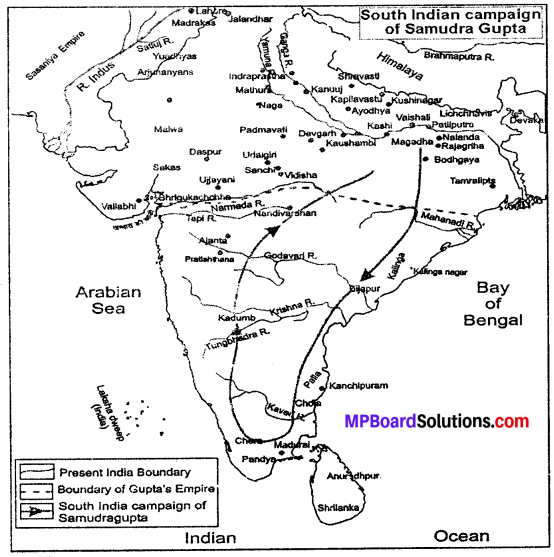
Samudra Gupta was a great Military commander, efficient politician and an invincible warrior. The famous historian Smith has called Samudra Gupta the ‘Indian Napoleon.’ Some of the Indian historians call Samudra Gupta greater and more practical than Napoleon because Samudra Gupta accomplished many victories but never incorporated the won states in his Empire nor did he try to impose his will upon these states. He only took gifts or taxes from’ the rulers and allowed the rulers to be independent but friendly states.
Question 7.
Write about the administrative organisation of Harsha – vardhan.
Answer:
Besides beings a conqueror, Harsha was also an able administrator, with a few changes he followed the Gupta organization. The pattern of Harsha’s administration was monarchical. The Emperor had the most prominent place in the central administration. He was the chief of the army and the highest court of appeal.
Tire main aim of the rule was the welfare of the subjects. There were many ministers and secretaries to assist the Emperor. The King was not bound to the decisions of the Council of Ministers. There were departmental heads like Mahasenapati (Commander in chief) and Maha Sandhivigrahdhikrt (Secretary of war and power).
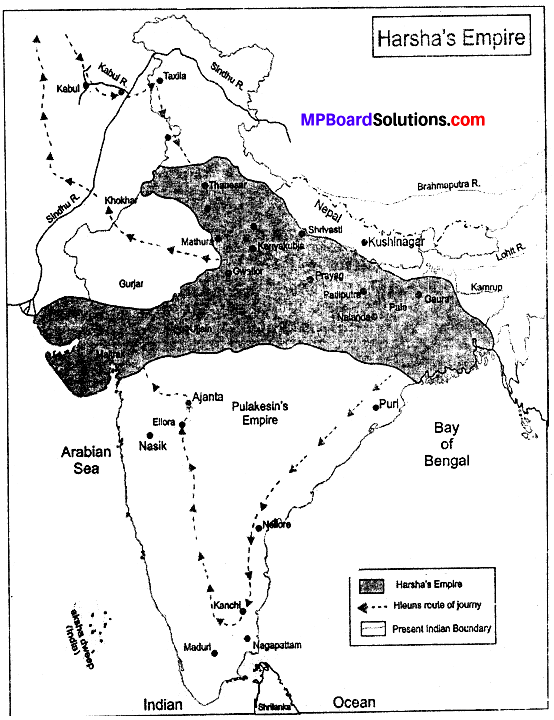
For administrative convenience the vasts .empire was divided into provinces. Province-were called Bhukti or Desh. The administrator of Bhukti was called Uparik. Only the princes of the royal dynasty or members of The royal family were appointed to these positions. Each province was divided into various Vishayas (districts).
The administrators of Vishayas were called Vishayapati. He supervised the various activities of the district. The smallest unit of administration was the village. Harsha had a large army. The code of punishment during Harsha’s period was very strict. There were capital punishments for some crimes. Due to the strict code of punishment the rate of crime was less.
The sources of information on Harsha have been derived from Bana’s Harsha Charita and Chinese traveler Hieun Tsang’s travelogues. The chief source of states income was land revenue. Generally land revenue was one/sixth of the produce. Taxes could be paid in the form of grain. Besides markets river banks tax on traders and fines were chief sources of state income.
The sources of information on Harsha have been derived from Bana’s Harsha Charita and Chinese traveler Hieun Tsang’s travelogues. The chief source of states income was land revenue. Generally land revenue was one / sixth of the produce. Taxes could be paid in the form of grain. Besides markets river banks tax on traders and fines were chief sources of state income.
![]()
MP Board Class 9th Social Science Chapter 9 Other Important Questions
Choose the correct answer:
Question 1.
(i) Who did write Rajtarangini?
(a) Kautilya
(b) Panini
(c) Kalhan
(d) None of the above.
Answer:
(c) Kalhan
Question 2.
From geographical point of view the world’s largest civilization is –
(a) Harppan civilization
(b) Vedic civilization
(c) Epic period civilization
(d) None of the above.
Answer:
(a) Harppan civilization
Question 3.
The most ancient epic is –
(a) Yajurveda
(b) Rigvdea
(c) Samveda
(d) Atharvaveda.
Answer:
(b) Rigvdea
Question 4.
Vanprastha means –
(a) family life
(b) retirement from family life
(c) giving up of worldly affairs
(d) None of the above.
Answer:
(b) retirement from family life
Question 5.
The founder of Gupta dynasty was
(a) Sri Gupta
(b) Samudra Gupta
(c) Skanda Gupta
(d) None of the above.
Answer:
(a) Sri Gupta
Question 6.
Which Gupta ruler has been called the ‘Indian Napolean’?
(a) Skanda Gupta
(b) Samudra Gupta
(c) Sri Gupta
(d) Chandragupta
Answer:
(b) Samudra Gupta
Match the following:
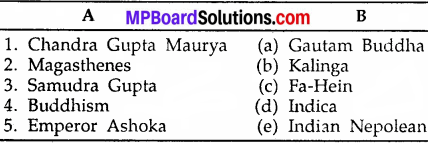
Answer:
1. (c) Fa-Hein
2. (d) Indica
3. (e) Indian Nepolean
4. (a) Gautam Buddha
5. (b) Kalinga
Fill in the blank:
- In ……………….. many janpads are mentioned.
- Mohen-jo-dro was discovered in 1922 by …………….
- Rigveda, Yajurveda and Samveda are called …………….
- ………….. is the oldest work in the world.
- Buddha was born at ……………..
Answer:
- Mahabharata
- Rabhaldas
- Vedatriji
- Rigveda
- Lumbini.
![]()
MP Board Class 9th Social Science Chapter 9 Very Short Answer Type Questions
Question 1.
Write the name of two epics.
Answer:
Mahabharata and Ramayan.
Question 2.
What is the literal meaning of ‘Mohen-jo-daro’?
Answer:
The literal meaning of Mohen-jo-daro is ‘The Mound of the Dead.’
Question 3.
What is known as Vedic civilization?
Answer:
Rigveda, Yajurveda, Samveda, Atharvaveda – These four Vedas together with other contemporary literary works is known as vedic civilization.
Question 4.
Name the four varnas.
Answer:
Brahmins, Kshatriya, Vaishyas and Shudras.
Question 5.
What was the commander of the army called during vedic civilization?
Answer:
He was called Senani.
Question 6.
Which two religions emerged during the period 6th century B.C.?
Answer:
Jainism and Buddhism emerged during the period 6th century B.C.
Question 7.
What is the main principle of Jainism?
Answer:
The main principle of Jainism is Ahimsa or nonviolence.
![]()
Question 8.
Name three famous rulers of the Mauryan empire?
Answer:
Chandra Gupta Maurya, Bindusar and Asoka-the-Great.
Question 9.
Whom did Chandra Gupta defeat in around 305 B.C.?
Answer:
Chandra Gupta defeated the Greek Commander Seleucus Nicator in around 305 B.C.
Question 10.
Who fought a war with Kalinga?
Answer:
King Asoka fought a war with Kalinga.
Question 11.
What do you know about Asoka’s Dharma?
Answer:
Asoka’s Dharma was the summary of all religions. It aims for the welfare of all. It aims at mental, moral and spiritual upliftment of all living beings.
Question 12.
Who was the last Mauryan ruler?
Answer:
The last Mauryan ruler was Brihadrath.
Question 13.
What happened to him?
Answer:
He was killed by his commander Pushyamitra Sunga.
Question 14.
When did Harsha become ruler of Thanesar?
Answer:
Harsha became the ruler of Thanesar in 606 A.D.
![]()
Question 15.
Write the two sources of information on Harsha.
Answer:
The two sources of information on Harsha are Bana’s Harsha Charita – and Chinese traveler Hieun Tsang’s travelogues.
MP Board Class 9th Social Science Chapter 9 Short Answer Type Questions
Question 1.
Mention the chief civilizations and dynasties of Ancient India in Chronological order.
Answer:
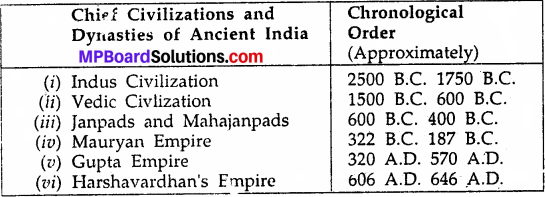
Question 2.
Describe the literary sources that throw light on ancient Indian history.
Answer:
Indian literature has worldly and religious elements. Vedas (Rigveda, Samaveda, Yajur / eda and Atharvaveda) Aranyakas, Upanishads, Vedangs, Sutras, Epics (Mahabharata and Ramayana) Smrities, Puranas, Buddhist liters Lure, Jain literature, Visakhadutta’s Mudrarakshhas, Kautilya’s Arthashastra, Patanjali’s Mahabhashya, Panini’s Ashtadhyayi, Kalhan’s Rajtarangini and other literary sources are chief sources of information about ancient Indian geographical, political, cultural, religious and economic life.
Question 3.
Write a note on ‘Public Bath’.
Answer:
In the excavations of Mohen – jo – daro a big bath has been found which is rectangular. It has a balcony on all the four sides and there are rooms behind the balconies, swimming pool and big wells to fill water in.
Every corner of the bath has staircase and the bath is made of baked bricks. This bath probably had religious significance and on sacred occasions people bathed in it. The great bath was so well constructed that it exists even today.
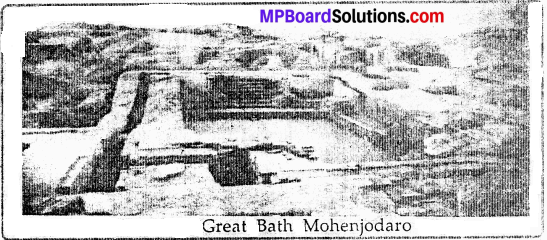
Question 4.
Write a note on Jainism.
Answer:
Vardharnan Mahavir was the 24th Tirthankar of the Jain religion. Mahavir was born to King Siddharth of Kundgrama. Vardharnan (Mahavir) was thoughtful and sober since childhood. He renounced the world after the death of his father. He attained Kaivalyagyan (highest knowledge) after 12 year’s of penance and meditation.
He was called a Jain (or victor over senses) as he got victory over his senses; and his followers were called Janis. The main principle of Jainism is Ahimsha or non – violence. According to Jainism non – violence it is not enough to refrain from violence but violence in thought, speech and allowing violence by others was also against religion. Mahavira professed the five vows.
Question 5.
Describe the chief features of Asoka’s Dharma.
Answer:
The chief features of Asoka’s Dharma are:
- Sovereignty.
- Importance given to self – discipline and etiquette.
- Non – violence and religious tolerance.
- Prominence of moral values.
- Explains on practicing truth in life.
![]()
Question 6.
What were the causes of downfall of the Mauryan Empire?
Answer:
There were several causes of downfall of the Mauryan Empire:
- The successors of Asoka were incapable. They divided the Empire among themselves and could not keep the Empire of their ancestors intact.
- The oppression of Provincial officers.
- Lack of nationalism in the subjects.
- Asoka’s policy of non-.violence made Military administration weak.
- There was lethargy also in the administrative system.
Question 7.
Some of the Indian historians call Samudra Gupta greater and more practical than Napoleon. Justify it.
Answer:
Samudra Gupta was really greater and more practical than Napoleon beacuse he (Samudra Gupta) accomplished many victories but never incorporated the won states in his empire nor did he try to impose his will upon these states. He only took gifts or taxes from the rulers and allowed the rulers to be independent but friendly states.
Question 8.
How can you say that Harsha was one of the greatest rulers of India?
Answer:
Harsha was one of the greatest rulers of India. It is generally believed that Harshvardhan had control over the entire northern India. He was a great conqueror, able administrator promoted welfare of the people. He was religious person and a patron of learning. Due to his victories and spread of religious works he has been called an assimilation of Samudra Gupta and Asoka.
MP Board Class 9th Social Science Chapter 9 Long Answer Type Questions
Question 1.
Describe the contribution of Chandra Gupta II in consolidating and strengthening the Gupta Empire.
Answer:
Chandra Gupta II, also known as Vikramaditya, was a great ruler of the Gupta Empire. His contribution to the Empire is noteworthy.
1. Chandra Gupta – II married Kubernaga of the Naga dynasty. This led to friendly relations between both the dynasties. He married his daughter Prabhavati Gupta to Rundrasena II the Vakataka King. This relationship secured Chandra Gupta’s control over the Sakas.
These matrimonial alliances proved to be politically very important. The daughter of Kadama dynasty was also married in the Gupta dynasty. Due to this matrimonial alliance the glory of. Chandra Gupta II spread to southern India as well.
2. An important achievement of Chandra Gupta – II’s reign was victory over Sakas. As a result of this victory western Malwa, Gujarat, Saurashtra, states of Kathiawad came under the Gupta Empire. The western boundaries of Gupta empire reached the Arabian sea.
3. Chandra Gupta – II is also described as Vikramaditya. He was an able politician. He was a great victor, able administrator, admirer of knowledge, benevolent, and protector of intellectuals. Among the Navratnas (nine Gems) in his court Kalidas was supreme.
During Chandra Gupta’s period science, architecture, sculpture, saw remarkable progress. The Chinese traveler Fa-Hein came during his reign and stayed in India from 405-411 A.D. In his travelogues he has described the contemporary political, social and economic condition of India.
![]()
Question 2.
Describe the social and economic life of the Indus civilization.
Answer:
Social life in the Indus Civilization:
The study of the archaeological sources the Tarappan civilization proves that the society was divided into various groups. The prominent among them were potters, carpenters, weavers, plumbers, masons, artisans, bricks makers, bead-makers and sculptors. During the period, the priests must have occupied an important position and performed special duties. The remains found at Mohen – jo – daro point in this direction.
Besides these bureaucrats, military and government officials, intellectuals and traders and laborers also resided. The people of the Tarappan civilization had an artistic bend of mind. The people of the Harappan civilization were well versed in the art of hairstyles, indulged in ornaments and cosmetics. During this period people excelled in singing, music, dance etc. The statue of a dancing girl found during the excavation certifies the same.
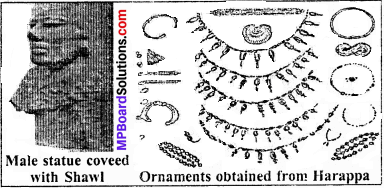
Food habits of the period included both vegetarian and non-vegetarian food. Ornaments were made of copper, bronze, shells, ivory, clay beads, beads made of horn and bones, hair clips, finger rings, bangles, necklace, amulets, bracelet, anklets, earrings were worn as ornaments.
They were also fond of hunting. From the remains found at Mohen-jo-daro a Yogi’s image on one of the seal (resembling Pashupatinath – Shiva) Rock Lin – gas (resembling Shiv Linga) can form an idea of the religious beliefs of the people. Besides these evidences of worship of snake, trees, the sun and water have also been found from excavation.
Economic Life in the Indus Civilization:
The economy I of this period was well developed. Agriculture was the main occupation. Besides agriculture, animal rearing, industry, internal and external trade, statue making industry, bricks industry, sculpture etc. were the chief industries. Indus people had trade relations.